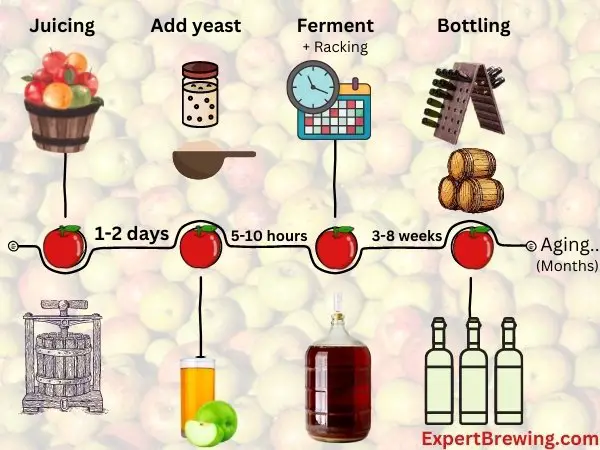As an experienced home cider maker, I am often asked about the benefits and drawbacks of cold crashing cider. Cold crashing is the process of rapidly cooling your fermenting cider to near-freezing temperatures in order to encourage yeast and other particulates to settle out of suspension, resulting in a clearer product.
Cold crashing cider can be beneficial for clarity and sediment reduction, but it may also slow fermentation and affect flavor.
While some argue that cold crashing is an essential step in producing high-quality cider, others believe it is an unnecessary complication that can lead to unforeseen issues.
In this blog post, we will explore the pros and cons of cold crashing cider to help you make an informed decision on whether or not to incorporate this step into your cider-making process.
In essence, these are the pros and cons of cold crashing your cider:
The Benefits of Cold Crashing Cider
There are several advantages to cold crashing your cider before packaging. These include:
1. Improved clarity: Cold crashing encourages yeast and other particulate matter to settle out of suspension, resulting in a clearer final product.
2. Reduced sediment in bottles: By encouraging yeast to settle at the bottom of the fermenter, cold crashing can help reduce the amount of sediment in your bottles or kegs.
3. Faster maturation: Cold crashing can help speed up the maturation process of your cider, as the yeast has already settled out, and the beer has been exposed to cold temperatures.
4. Stabilization of flavors: Cold crashing can help stabilize the flavors in your cider, as it reduces the chance of further fermentation or changes in the cider’s composition due to yeast activity.
The Drawbacks of Cold Crashing Cider
While cold crashing has its benefits, there are also some potential drawbacks to consider:
1. Risk of oxidation: When cider is exposed to cold temperatures, it can absorb more oxygen, which can lead to oxidation and off-flavors in the finished cider.
2. Potential for contamination: Cold crashing requires opening the fermenter and potentially exposing your cider to contaminants, such as bacteria or wild yeast, which can spoil your cider.
3. Additional equipment needed: To cold crash your cider effectively, you’ll need a temperature-controlled environment, such as a refrigerator or temperature-controlled fermentation chamber. This can be an additional expense and take up valuable space in your home brewery.
4. Potential impact on yeast health: While cold crashing does not kill yeast, it does cause them to become dormant, which may impact their overall health and vitality. This can be a concern if you plan to harvest and reuse your yeast for future batches.
1. Improved Clarity and Appearance
One of the main benefits of cold crashing cider is the improvement in clarity and appearance. Cold crashing helps to separate suspended particles, such as yeast and sediment, from the liquid, resulting in a clearer and more attractive final product.

This is particularly important if you plan on sharing your cider with friends and family or entering it into competitions. A clear, bright cider is not only more visually appealing but also indicates a well-made product.
2. Reduced Sediment
In addition to improving clarity, cold crashing also helps to reduce the amount of sediment in your finished cider. Sediment can be off-putting to some drinkers and may impact the overall flavor and mouthfeel of your cider. By cold crashing, you can minimize the amount of sediment that makes its way into your bottles or kegs, ensuring a more enjoyable drinking experience for you and your guests.
3. Stabilization of Flavors
Another benefit of cold crashing is the potential stabilization of flavors. As the cider cools, the yeast and other compounds in suspension will settle out, allowing the flavors to meld and mature. This can result in a smoother, more refined final product that showcases the apples’ natural flavors and characteristics.
4. Faster Finishing Time
Cold crashing your cider can also help to speed up the finishing process for your cider. By encouraging the yeast to settle out of suspension more quickly, you can shorten the amount of time your cider needs to sit and clear before it is ready for consumption. This can be particularly helpful for those looking to turn around a batch of cider in a relatively short amount of time.

5. Potential for Incomplete Fermentation
One of the potential drawbacks of cold crashing is the risk of incomplete fermentation. When you rapidly cool your cider, it can cause the yeast to go dormant before it has finished fermenting all available sugars. This can result in a cider that is sweeter and higher in residual sugar than you initially intended. Depending on your personal preferences, this may or may not be a desirable outcome.
6. Slower Fermentation Restart
If you decide to cold crash your cider but later determine that you would like to restart fermentation, you may encounter some difficulties. Cold crashing can cause the yeast to go dormant, making it more difficult to “wake up” and resume fermentation. This can result in a longer and more unpredictable fermentation process, which may be frustrating for some home cider makers.
7. Impact on Flavor
While cold crashing can help to stabilize and refine flavors, it may also impact the overall flavor profile of your cider. Some argue that cold crashing can strip away some of the more delicate and nuanced flavors in your cider, resulting in a less complex and interesting final product. This is a matter of personal preference and may vary depending on the specific apples and yeast strains used in your cider.
8. Equipment and Space Requirements
Another potential downside to cold crashing is the need for additional equipment and space. In order to cold crash your cider, you will need a method for rapidly cooling and maintaining the temperature of your fermentation vessel, such as a refrigerator or temperature-controlled fermentation chamber. This can be a significant investment for some home cider makers and may not be feasible for those with limited space.
9. Risk of Contamination
Finally, there is a small risk of contamination associated with cold crashing. When you open your fermentation vessel to transfer your cider to another container for cold crashing (or transfer it back to rack of the yeast sediment), you introduce the potential for unwanted bacteria or wild yeast to enter your cider. While this risk is relatively low, it is still something to consider when deciding whether or not to cold crash your cider.
In conclusion, whether or not you should cold crash your cider depends on your personal preferences, equipment, and goals for your final product.
To help you make an informed decision, consider these 10 key facts about cold crashing cider:
1. Cold crashing can improve clarity and appearance.
2. It can reduce sediment in the finished cider.
3. Flavors may become more stable and mature through cold crashing.
4. Cold crashing can shorten the finishing time for your cider.
5. There is a risk of incomplete fermentation when cold crashing.
6. Restarting fermentation after cold crashing can be slower and more unpredictable.
7. Cold crashing may impact the overall flavor profile of your cider.
8. Additional equipment and space are required for cold crashing.
9. There is a small risk of contamination associated with cold crashing.
10. Ultimately, the decision to cold crash your cider depends on your personal preferences and goals for your final product.
Happy cider making!
FAQs
Is cold crashing necessary?
Cold crashing is not necessary, but it can improve the clarity and taste of certain types of beer by causing yeast and other particles to settle to the bottom of the fermenter.
Do you need to cold crash cider?
Cold crashing cider is not necessary, but it can improve the clarity and flavor of the final product. It involves lowering the temperature of the cider to near-freezing for a period of time to encourage yeast and other sediment to settle to the bottom. This can result in a clearer and crisper cider. However, if you prefer a more hazy or rustic cider, cold crashing may not be necessary.
Will cold crashing clear cider?
Yes, cold crashing can help clear cider by causing suspended particles to settle to the bottom of the container.
What is the best temperature for hard cider?
The best temperature for hard cider is typically between 45-55°F (7-13°C).
What are the benefits of cold crashing beer?
Cold crashing beer can help clarify the beer by causing yeast and other particles to settle to the bottom of the fermenter. This can result in a clearer and brighter beer with a better shelf life. It can also help reduce off-flavors and improve the overall taste of the beer.
Do you cold crash hard cider?
Yes, cold crashing hard cider is a common practice that helps to clarify the cider by settling out any remaining yeast and other particles. This is typically done by chilling the cider to near freezing temperatures for a period of time before bottling or kegging.




